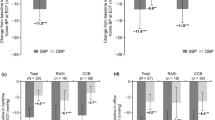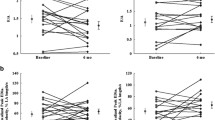Summary
It is now generally accepted that antihypertensive therapy can induce regression of left ventricular hypertrophy (LVH) in hypertensive subjects. However, the influence of LVH reversal on both the systolic and diastolic functions, and particularly the ability of the heart to meet sudden overloads caused by exercise and/or recurrence of hypertension, remain unanswered questions. The long-term effects of ketanserin, a selective serotonin S2-receptor antagonist with additional alpha1-adrenergic blocking properties, on LVH and systolic function were studied in 13 untreated subjects (age range 35–55 years) with mild-to-moderate essential hypertension, echocardiographic evidence of LVH, and normal ejection fraction. Blood pressure values and echocardiographic measurements of dimensions, wall thicknesses, and indices of LV mass were determined before and after 3, 6, and 12 months treatment; ejection fractions at rest and during exercise were evaluated by equilibrium multigated radionucleide angiocardiography at baseline and after 12 months of therapy. Mean arterial pressure was significantly reduced from the first month of treatment (p<0.001) and remained well controlled up to the end of the trial. Both posterior and septum wall thicknesses decreased after 3 months of therapy and remained stable throughout the whole study period. LV mass index decreased from a mean ± SD of 187.7±47.6 g/m2 to a mean of 157.81±31.63 g/m2 (p<0.01) at the third month, reaching greater decreases after 6 months (156.05±31.00 g/m2) and after 12 months (153.21±28.80 g/m2) of treatment. A significant correlation was found between LV mass and posterior wall thickness at the different observation times in the study. Finally, the regression of LVH at the end of therapy was not associated with impairment of systolic function, as assessed by measurements of ejection fraction at rest and during exercise.
Similar content being viewed by others
References
Kannel WB, Gordon T, Offutt D, et al. Left ventricular hypertrophy by electrocardiogram. Prevalence, incidence and mortality in the Framingham study. Ann Intern Med 1969;71:89–105.
Kannel WB, Castelli WP, McNamara PM, et al. Role of blood pressure in the development of congestive heart failure. The Framingham study. N Engl J Med 1972;287:781–787.
Frohlich ED, Tarazi RC. Is arterial pressure the sole factor responsible for hypertensive cardiac hypertrophy? Am J Cardiol 1979;4(5):959–963.
Strauer BE, Bayer F, Brecht HM, et al. The influence of sympathetic activity on regression of cardiac hypertrophy. J Hypertens 1985;3(Suppl 4):539–544.
Vanhoutte PM, Amery A, Birkenhager W, et al. Serotoninergic mechanisms in hypertension. Focus on the effects of ketanserin. Hypertension 1988;11:111–133.
Devereux RB, Alonso DR, Lutas EM, et al. Echocardiographic assessment of left ventricular hypertrophy: Comparison with necropsy findings. Am J Cardiol 1986;57:450–458.
Devereux RB, Reicheck N. Echocardiographic determination of left ventricular mass in man: Anatomic validation of the method. Circulation 1977;57:450–458.
Devereux RB. Detection of left ventricular hypertrophy by M-mode echocardiography. Hypertension 1987;9(Suppl 2):19–26.
Hains ADB, Al-Khawaja I, Hinge DA, et al. Radionuclide left ventricular ejection fraction: A comparison of three methods. Br Heart J 1987;57:242–246.
Caruana M, Al-Khawaja I, Lahiri A, et al. Radionuclide measurements of diastolic function for assessing early left ventricular abnormalities in the hypertensive patient. Br Heart J 1988;59:218–226.
SPSS-X. User's Guide, 2nd ed. Chicago:SPSS Inc, 1986.
Drayer JIM, Gardin JM, Weber LA, et al. Increases and decreases in ventricular septal thickness during diuretic therapy. Clin Pharmacol Ther 1982;32:283–287.
Drayer JIM, Gardin JM, Weber MA, et al. Cardiac muscle mass during vasodilation therapy of hypertension. Clin Pharmacol Ther 1983;33:727–732.
Sen S, Tarazy RC, Khairallad PA, et al. Cardiac hypertrophy in spontaneously hypertensive rats. Circ Res 1974;35:775–781.
Trimarco B, De Luca N, Cuocolo A, et al. Beta blockers and left ventricular hypertrophy in hypertension. Am Heart J 1987;114:975–983.
Author information
Authors and Affiliations
Rights and permissions
About this article
Cite this article
Coto, V., Cocozza, M., Oliviero, U. et al. Regression of left ventricular hypertrophy and systolic function in hypertensive patients during long-term treatment with ketanserin. Cardiovasc Drug Ther 4, 77–80 (1990). https://doi.org/10.1007/BF00053432
Issue Date:
DOI: https://doi.org/10.1007/BF00053432




